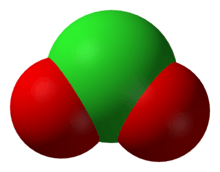Halite (oxyanion)
A halite, also known as a halogenite,[1] is an oxyanion containing a halogen in a III oxidation state. It is the conjugate base of a halous acid. The known halites are chlorite, bromite, and iodite.

Chlorite (ClO2−), a halite
Uses
Halites can be used to generate the respective halogen dioxides via a one-electron oxidation:
This reaction in particular is used in bleach to generate chlorine dioxide.
Stability
Chlorites tend to decompose rapidly, some even explosively, upon heating.[2] A few bromites have been isolated, but no iodites have.[3]
References
- Holleman, A. F.; Wiberg, Egon; Wiberg, Nils (2001). Inorganic Chemistry. Web: Academic Press. p. 439. ISBN 9780123526519. Retrieved 21 March 2019.
- Holleman, A. F.; Wiberg, Egon; Wiberg, Nils (2001). Inorganic Chemistry. Web: Academic Press. p. 445. ISBN 9780123526519. Retrieved 21 March 2019.
- Egon Wiberg, Arnold Frederick Holleman (2001) Inorganic Chemistry, Elsevier ISBN 0-12-352651-5
This article is issued from Wikipedia. The text is licensed under Creative Commons - Attribution - Sharealike. Additional terms may apply for the media files.